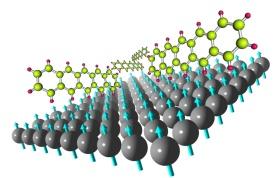

01/30/2012

Thin films of ferromagnetic metals play a pivotal role in a number of spintronics devices by exploiting the spin of electrons as well as their charge. A classic example is a spin valve in which magnetization of the ferromagnetic metal electrode controls the spin of electrical charges.
Perpendicular magnetic anisotropy (PMA) is an essential feature of ferromagnetic thin films which determines the complexity of magnetic switching using an external field. Although molecular layers deposited on ferromagnetic films in organic spin valve devices are known to affect their spin injection and detection efficiency, much less is known about their influence on magnetic properties.
Xianmin Zhang from the WPI-AIMR and co-authors at Tohoku University have now demonstrated that capping cobalt thin films with molecular layers can affect their PMA to different degrees depending on the nature of the deposited molecules1. The results are important for understanding the fundamental magnetic properties of cobalt films, and are also relevant to spin valves, in which molecular layers used as active elements are placed between electrodes of ferromagnetic metals.
The researchers selected fullerene molecules — hollow, spherical cages composed of sixty carbon atoms — along with the aluminum complex tris(8-hydroxyquinolinato) aluminum, and the linear aromatic molecule pentacene. Molecular layers of varied thickness were applied to cobalt films, and the team measured the magnetization loops of all structures under an external magnetic field positioned either parallel or perpendicular to the film plane. The data showed a good resemblance between the loops of fullerene and aluminum complex, but a striking difference in the case of pentacene, which exhibited a much higher coercive field of up to 160% more than that of the other two molecules.
Zhang and co-workers believe that the different magnetic behaviour observed is due to a difference in the nature of interactions at the cobalt–molecular layer interfaces, and they intend to conduct further experiments to investigate the origin of these behaviours. As the crystal structure of pentacene deposited on the cobalt film differed from those of the aluminum complex and fullerene, the researchers concluded that both the aluminum complex and fullerene are chemically bound to the cobalt film, whereas pentacene undergoes a process of physical adsorption, a weaker interaction in which the electronic structure of the molecule remains unchanged.
The results are expected to have an important impact on future research. “These findings likely open a new window to further understand the interactions at the interface between ferromagnetic metals and molecules or molecular assemblies, and may contribute to the design of new organic-inorganic hybrid spintronics devices in future," says Zhang.
Zhang, X., Mizukami S., Kubota, T., Oogane, M., Naganuma, H., Ando, Y. & Miyazaki, T. Interface effects on perpendicular magnetic anisotropy for molecular-capped cobalt ultrathin films. Applied Physics Letters 99, 162509 (2011). | article
This research highlight has been approved by the authors of the original article and all information and data contained within has been provided by said authors.